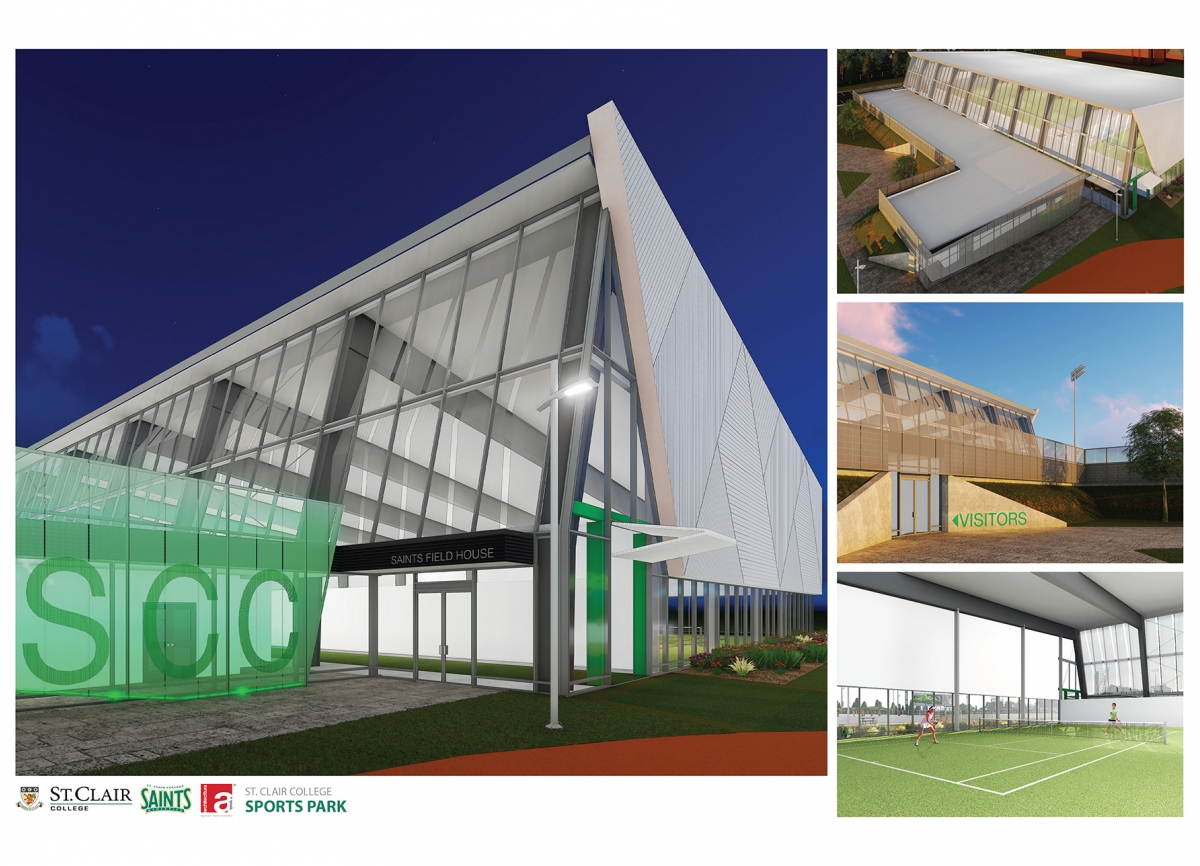
Among the items discussed and acted upon by the college’s Board of Governors (BofG) during its past few meetings were these …
PLANS FIRMED UP FOR SPORTS PARK
Most of the “t’s are crossed and the i’s are dotted” as the college pushes ahead with its plans to totally revamp its outdoor athletic facilities by developing a new “Sports Park”, to be located in the vicinity of existing recreational fields at the far south end of campus.
During its February meeting, the BofG received an update on the project in the form of a memo from President Patti France and Vice-President of International Relations, Training and Campus Development Ron Seguin.
It explained that the design, financing and operational plan for the Sports Park have been completed; the project will soon be tendered out to engage a contractor; and construction should get underway this spring.

Among the specific details noted by France and Seguin were these:
• The financing of the Sports Park will be the responsibility of the Student Representative Council (SRC). St. Clair College students have approved a fee protocol that establishes approximately $13 million in funding.
• The SRC will broker the delivery of varsity athletics, intramural and recreational activities to the Student Athletic Association (SAA). The Student Athletic Association has pledged one million dollars to the development of the Sports Park.
• The SRC, SAA and college’s administration have worked collaboratively to design the Sports Park’s features. They have established a "phased in" financial strategy that will construct the park in the following sequential order as it relates to cost estimates and funding capacity:
1. Walking path, streetscape lighting, landscaping and gateway entrance: $1,275,000;
2. Soccer Stadium: Artificial turf, lighting, dressing rooms, press box, concession, seating for 1,500 fans: $5,948,000;
3. Softball Stadium: Artificial turf, lighting, dressing rooms, press box, concession, seating for 650 fans: $3,610,000;
4. Sand Volleyball Courts: Four outdoor courts, lighting, food pavilion: $300,000;
5. Score Boards: Interactive "jumbo" score-board: $400,000;
6. Tennis Facility (futuristic): Five indoor tennis courts, pro shop, dressing rooms, viewing area: $5,000,000;
7. Soccer Dome (futuristic): Retractable dome on soccer field allowing play during winter months: $4,200,000 …
TOTAL (if all facets are eventually developed, including the last two items): $20,733,000.

By the way, in recognition of the college’s constantly increasing number of international students, the new facilities will also incorporate a cricket pitch.
Regarding the accompanying artist’s/architect’s conceptions of the Sports Park … The individual components are fairly accurate, but the geographical relationship between the facilities has been altered. The locations of the various fields and amenities have had to be shuffled because the Ministry of Transportation was concerned about foul-balls finding their way on to the Herb Gray Parkway from the softball diamond. It has now been moved to the east end of the grounds, and the soccer pitch to the west.
NEW PROGRAMS
Two new programs have been approved for launches in September of this year: a full, two-years-long diploma program in eSports Entrepreneurship and Management, and a one-year-long graduate certificate program in Data Analytics for Business.
The proposal for the eSports (networked computer gaming) program, presented by Vice-President Academic Waseem Habash and School of Business and Information Technology Chair James Marsh, explained:
The rationale for the program is as follows:
• Synergies with other programming at St. Clair College to create interprofessional education opportunities and pathways;
• Increase student engagement and awareness of the EPICGenesis Centre with promotion and support of entrepreneurship;
• Support and collaboration with the Saints eSports varsity team;
• Unique programming (rare in Ontario and Canada) to assist in making St. Clair a "destination of choice" for domestic students;
• There is a growing demand for this program from the gaming generation, and there will be many future job opportunities in this field.
This program will prepare students to work in the interactive business of eSports, learning the practical business and entrepreneurial skills, and developing comprehensive and foundational knowledge of eSports, including: sports management, communications, leadership, entrepreneurship, business development and social media will be included in the courses of study.
Students will also learn a unique blend of eSports gaming topics, including: the history of eSports, game design, event and team management, broadcast and content creation, hardware and software.
Students will also participate in a variety of relevant, practical learning experiences that will allow them to integrate the knowledge gained throughout the program in the planning, development and execution of eSports experiences and projects.
Graduates will be prepared to pursue a variety of career opportunities, such as team and league managers, marketing and promotion, event management, and as eSports livestream technicians.
The budget indicates that the financial impact would see the program at a break-even position after the third year, and could provide a Net Present Value (“profit”) of $201,233 in five years.
The introduction of this program would require the college to hire (new) faculty in the first and third years of operation.
Habash also described the new Data Analytics program:
Marketing for this program will primarily be directed towards International students.
The rationale for the program is as follows:
• Data analytics is a growing field and will provide many employment opportunities for graduates;
• Increases international enrolment;
• Closes skills gap in a growing field;
• Enhances employability skills;
• Supports local business and manufacturing bases;
• Synergies with other programming within the School of Business and Information Technology to create interprofessional education opportunities, specifically Computer Networking, Mobile Applications and Web Development.
Graduates of this program may find employment in various information technology consulting firms and within information technology fields, both in the private and public sectors. Potential employment may include data administration (DBAs), database analysts, database architects, data warehouse analysts, technical database architects and other areas dealing with "Big Data".
The financial impact of this program demonstrates that it could show a small profit in its first year, and could provide a Net Present Value (“profit”) of $1 million at the five-year mark.
The introduction of this program would require the college to hire (new) faculty in its first and second years.
BUDGET UPDATE
With two months remaining in the college’s fiscal year (it ends on March 31), Chief Financial Officer Marc Jones presented the BofG with the Financial Monitoring Report, showing revenues and expenditures as of January 31.
Ten months of revenues total $123.9 million – up $10.2 million compared to the same time-span in 2016-17.
The lion’s share of that increase takes the form of tuition from increased enrolment. Specifically, tuition from international students is up $8.3 million compared to 2016-17, thanks to the 2,600 foreign enrollees who are here this year.
Domestic/Canadian tuition revenue is down $1.9 million, due to the 1,200 students who withdrew-with-refunds as a result of the first semester’s faculty strike. That was coupled with the loss of approximately 1,100 other students who failed or quit at the end of that semester.
The substantial enrolment at St. Clair’s “sister school” in Toronto, the Ace Acumen Academy, also contributed to the healthy revenue picture – but that is a short-lived blessing. The provincial Ministry of Advanced Education and Skills Development has ordered the “wind-down” (elimination) of public/private college partnerships. The St. Clair/Acumen partnership will cease to exist at the end of the 2019-20 academic year. (See the Scene’s story about the public/private partnership wind-down, from last September, at http://stclair-src.org/news/need-know-news/publicprivate-college-partnerships-mothballed.)
Total expenditures, as of January 31, stand at $102.1 million, up slightly from the same date a year ago ($101.8 million).
“Actual” salaries-and-benefits, the chief expenditure of any business or institution, are slightly below what had been budgeted at the beginning of the year – chiefly because of money-not-spent during the faculty strike, But that number will probably be fairly close to the original forecast by the end of the fiscal year when the professors’ new wage hike is added to the mix. Jones’ report also informed the Governors that “the administration continues to closely monitor the implications from Bill 148” (higher wages for part-timers).
At the moment, therefore, revenues-minus-expenditures (as of the end of January) show the college with a whopping surplus of approximately $21.75.
Last March, when the budget was passed, a very conservative outlook had projected a year-end surplus of only $1.18 million.
The remaining two months of the year will eat into the hefty surplus revealed at January’s month-end (Bill 148’s impact, end-of-year invoice payments, etc.) …
… But, still, the college should end the year in a very solid financial position – probably in the neighbourhood of a $5 million surplus, Jones said …
… Some of that money will, probably, be immediately injected into classroom improvements and expansions. As the school awaits the construction of its new Business Tower within the next couple of years, it still needs additional space to handle what is expected to be continuing enrolment increases (particularly international students).
And setting aside some of the surplus into reserves may also be advisable (and desirable) as the school prepares for the loss of Acumen-generated tuition revenues within the next couple of years.







